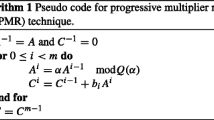Abstract
The Residue number system (RNS) is inherently suited to high speed computations using custom tailored VLSI systems. In this paper, an algorithm for residue addition, based on a novel, ‘non unique’ number representation scheme, is implemented by a systolic array embedded in a VLSI chip. The pipelined cells are implemented, using a true single phase clock dynamic circuit structure, with computer synthesized minimized trees (switching trees). The array may be easily programmed by the user to accept any arbitrary modulus. Important applications of this array are in residue decoding and fault tolerant computation requiring the use of the Chinese Remainder Theorem where the modulus for addition is relatively large.
Similar content being viewed by others
References
M.A. Soderstrand, W.K. Jenkins, G.A. Jullien, and F.J. Taylor,Residue Number System Arithmetic: Modern Applications in Digital Signal Processing IEEE Press, 1986.
F.J. Taylor, “Residue Arithmetic: A Tutorial with Examples,”IEEE Computer Magazine, 17, pp. 50–62, 1984.
N.S. Szabo and R.I. Tanaka,Residue Arithmetic and its Applications to Computer Technology. New York: McGraw-Hill, 1967.
W.K. Jenkins, “A Technique for the Efficient Generation of Projections for Error Correcting Residue Codes,”IEEE Trans. Comput., C-22, pp. 762–767, 1973.
W.K. Jenkins, “Techniques for Residue-to-Analog Conversion for Residue-Encoded Digital Filters,”IEEE Trans. Circuits Syst., CAS-25, pp. 555–562, 1978.
A. Baraniecka, and G.A. Jullien, “On Decoding Techniques for Residue Number System Realizations of Digital Signal Processing Hardware,”IEEE Trans. Circuits Syst., CAS-25, pp. 935–936, 1978.
F.J. Taylor and A.S. Ramnarayanan, “An Efficient Residue-to-Decimal Converter,”IEEE Trans. Circuits Syst., CAS-28, pp. 1164–1169, 1981.
M.A. Soderstrand, C. Vernia, and J.H. Chang, “An Improved Residue Number System Digital-to-Analog Converter,”IEEE Trans. Circuits Syst., CAS-30, pp. 903–907, 1983.
T.V. Vu, “Efficient Implementations of the Chinese Remainder Theorem for Sign Detection and Residue Decoding,”IEEE Trans. Comput., C-34, pp. 646–651, 1985.
G.A. Jullien, “Residue Number Scaling and Other Operations Using ROM Arrays,”IEEE Trans. Comput., C-27, pp. 325–336, 1978.
M.A. Bayoumi, G.A. Jullien, and W.C. Miller, “A Look Up Table Methodology for RNS Structures Used in DSP Applications,”IEEE Trans. CAS, CAS-34, pp. 604–616, 1987.
K. Hwang,Computer Arithmetic: Principles, Architecture and Design. John Wiley, 1979.
S. Bandyopadhyay, G.A. Jullien, and M. Bayoumi, “Systolic arrays over finite rings with applications to digital signal processing,”Systolic Array Workshop, Oxford, pp. 123–131, 1986.
K.M. Elleithy, M. Bayoumi, and K.P. Lee, “O(logN) Architectures for RNS Arithmetic Decoding,”9th IEEE Symposium on Computer Arithmetic, pp. 202–209, 1989.
G.A. Jullien, W.C. Miller, R. Grondin, Z. Wang, D. Zhang, L. Del Pup, and S. Bizzan, “WoodChuck: A Low-Level Synthesizer for Dynamic Pipelined DSP Arithmetic Logic Blocks,”1992 IEEE Int. Symp. on Circuits and Systems, San Diego, pp. 176–179, 1992.
J. Yuan and C. Svensson, “High-Speed CMOS Circuit Technique,”IEEE. J. Solid-State Circuits, 24, pp. 62–70, 1989.
N.M. Wigley, G.A. Jullien, D. Reaume, and W.C. Miller, “Small Moduli Replications in the MMRNS,”10th IEEE Symposium on Computer Arithmetic, Grenoble, pp. 92–99, 1991.
C.N. Zhang, B. Shirazi, and D.Y.Y. Yun, “Parallel Designs for Chinese Remainder Conversion,”International Conference on Parallel Processing, Chicago, pp. 557–559, 1987.
M. Griffin, F. Taylor, and M. Sousa, “New Scaling Algorithms for the Chinese Remainder Theorem,”22nd Asilomar Conference on Signals, Systems and Computers, pp. 375–378, 1988.
S. Bandyopadhyay, G.A. Jullien, and A. Sengupta. “A systolic architecture for implementing the Chinese Remainder Theorem,”International Conference on Parallel Processing, Chicago, pp. 924–931. (This paper was inadvertently omitted from the Conference Proceedings. Copies of the paper may be obtained from the first author.), 1987.
S. Bandyopadhyay, G.A. Jullien, and A. Sengupta, “A systolic array for fault tolerant digital signal processing using a residue number system approach,”International Conference on Systolic Arrays, pp. 577–586, 1988.
Author information
Authors and Affiliations
Rights and permissions
About this article
Cite this article
Bandyopadhyay, S., Jullien, G.A. & Sengupta, A. A fast VLSI systolic array for large modulus residue addition. Journal of VLSI Signal Processing 8, 305–318 (1994). https://doi.org/10.1007/BF02106454
Published:
Issue Date:
DOI: https://doi.org/10.1007/BF02106454




